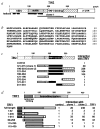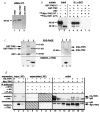TIN2, a new regulator of telomere length in human cells
- PMID: 10581025
- PMCID: PMC4940194
- DOI: 10.1038/70508
TIN2, a new regulator of telomere length in human cells
Abstract
Telomeres are DNA-protein structures that cap linear chromosomes and are essential for maintaining genomic stability and cell phenotype. We identified a novel human telomere-associated protein, TIN2, by interaction cloning using the telomeric DNA-binding-protein TRF1 as a bait. TIN2 interacted with TRF1 in vitro and in cells, and co-localized with TRF1 in nuclei and metaphase chromosomes. A mutant TIN2 that lacks amino-terminal sequences effects elongated human telomeres in a telomerase-dependent manner. Our findings suggest that TRF1 is insufficient for control of telomere length in human cells, and that TIN2 is an essential mediator of TRF1 function.
Figures







Comment in
-
At the end of the millennium, a view of the end.Nat Genet. 1999 Dec;23(4):382-3. doi: 10.1038/70480. Nat Genet. 1999. PMID: 10581016 No abstract available.
References
-
- Blackburn EH. Structure and function of telomeres. Nature. 1991;350:569–573. - PubMed
-
- Aparicio OM, Billington BL, Gottschling DE. Modifiers of position effect are shared between telomeric and silent mating-type loci in S. cerevisiae. Cell. 1995;66:1279–1287. - PubMed
-
- Brachmann CB, et al. The SIR2 gene family, conserved from bacteria to humans, function in silencing, cell cycle progression and chromosome stability. Genes Dev. 1995;9:2888–2902. - PubMed
-
- Marchand S, Buck SW, Moretti P, Gilson E, Shore D. Silencing of genes at nontelomeric sites in yeast is controlled by sequestration of silencing factors at telomeres by RAP1 protein. Genes Dev. 1996;10:1297–1309. - PubMed
-
- Campisi J. The biology of replicative senescence. Eur J Cancer. 1997;33:703–709. - PubMed
Publication types
MeSH terms
Substances
Associated data
- Actions
Grants and funding
LinkOut - more resources
Full Text Sources
Other Literature Sources
Molecular Biology Databases
Research Materials
Miscellaneous

